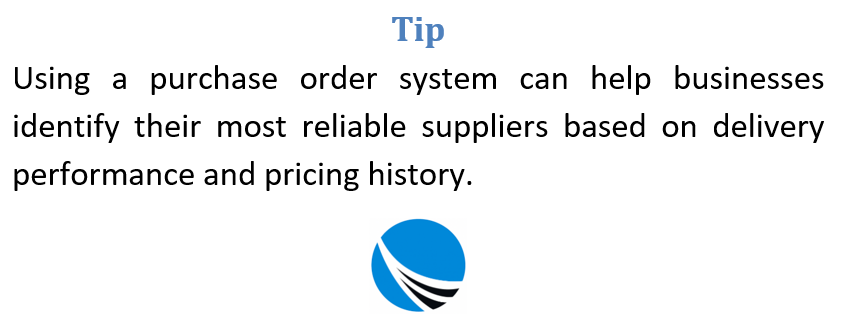Every business that deals with acquiring goods or services needs a structured way to record, track, and manage those transactions. Purchase orders (POs) serve as formal documents that help ensure clarity between buyers and suppliers. While verbal agreements or casual emails can lead to confusion or disputes, a PO eliminates ambiguity by laying out the specifics of a transaction in black and white.
Simply put, a purchase order is a written commitment by a buyer to purchase products or services at agreed terms. It specifies quantities, pricing, and delivery details and serves as a reference point for invoicing, inventory updates, and project cost tracking.
Businesses that implement a reliable purchase order system benefit from smoother operations, better oversight, and enhanced financial management. Let’s explore how such systems work and what advantages they bring.

How a Purchase Order System Enhances Business Operations
A purchase order system automates and centralizes the process of ordering, tracking, and paying for goods and services. It replaces disorganized communication with a streamlined workflow, minimizing errors and reducing administrative burden.
By using a digital or structured PO system, businesses can align procurement with budgeting, stock control, and project planning. It’s not just about placing an order—it’s about ensuring visibility, accountability, and strategic resource use.
If you’re considering whether a PO system is right for your business, here are six compelling reasons why it can be a game-changer.
1. Ensures Accuracy and Reduces Miscommunication
Clear communication is crucial in procurement. When orders are placed over the phone or via informal channels, there’s a risk of misinterpretation. With a purchase order system, each transaction is clearly documented.
A standard PO includes all critical information: item specifications, quantities, agreed prices, payment terms, and delivery schedules. This clarity benefits both parties by preventing misunderstandings, simplifying dispute resolution, and ensuring that suppliers deliver exactly what was requested.
Additionally, once a supplier accepts the purchase order, it becomes a binding agreement, offering legal protection for both sides in case of discrepancies or incomplete deliveries.
2. Enhances Cost Tracking for Projects
When businesses undertake multiple projects simultaneously, keeping financial records accurate can become challenging. A purchase order system allows companies to associate specific purchases with corresponding projects or departments.
This level of categorization enables project managers to keep tabs on spending in real time, compare actual costs with budgets, and forecast future procurement needs. Instead of relying on guesswork or manual recordkeeping, a PO system provides timely insights that support smarter decision-making.
It also ensures that procurement aligns with pre-approved budgets, helping avoid overspending or duplication of orders.

3. Improves Efficiency and Saves Time
Processing invoices manually can be time-consuming. Verifying that an invoice matches the ordered quantity, price, and delivery terms often involves going back and forth between departments.
With a purchase order system in place, much of this work is automated. When a supplier submits an invoice referencing a PO, the system can instantly verify whether the invoice matches the original order. If everything checks out, payment processing can move forward with minimal delay.
This automation reduces the workload for finance and admin teams, speeds up processing, and ensures data integrity. It also helps prevent unauthorized or fraudulent purchases.
4. Enables Eligibility for Public Sector Contracts
Many public agencies, including local councils and national government departments, require vendors to work with formal purchase orders. Without the ability to generate and process POs, your business might be shut out of these potentially lucrative opportunities.
Having a purchase order system in place demonstrates professionalism and financial discipline—qualities government agencies look for in suppliers. It signals that your business has the controls in place to manage resources responsibly and comply with auditing standards.
In competitive bidding processes, this level of organization can give your business a distinct advantage.
5. Supports Better Inventory Management
One of the biggest challenges in business is balancing inventory—having enough stock to meet demand without tying up too much capital. A PO system plays a critical role here by offering real-time insight into what has been ordered, what’s on backorder, and when deliveries are expected.
This visibility helps avoid both overstocking and stockouts. Businesses can maintain optimal inventory levels by using reorder points, stock thresholds, and tracking supplier delivery patterns. With access to such information, you can plan procurement in advance and keep your operations running smoothly.
Moreover, purchase order records help calculate product costs accurately, which is essential for pricing strategies and profitability analysis.
6. Helps Identify Your Best Suppliers
A purchase order system also acts as a supplier performance tracker. By analyzing historical order data, businesses can identify which suppliers consistently deliver on time, offer competitive pricing, and respond effectively to issues.
This information is valuable when negotiating terms, consolidating vendors, or making decisions about preferred suppliers. You might find that certain vendors offer better bulk discounts, superior service, or shorter lead times—insights that are difficult to gather without organized records.
A PO system allows you to assess vendor reliability and ensure your supply chain is supported by strong, consistent partnerships.
Wrapping Up: Why a PO System Is Worth the Investment
Managing procurement without a structured system can lead to inefficiencies, financial blind spots, and missed opportunities. A purchase order system acts as a central hub for managing spending, maintaining transparency, and improving communication with suppliers.
From ensuring accurate recordkeeping to streamlining workflow, from enabling project-level cost tracking to strengthening supplier relationships, the benefits of using a PO system are far-reaching.
It’s not just a tool for large corporations—even small businesses can benefit significantly from implementing a basic yet functional purchase order system. Whether you’re scaling up or simply aiming to improve operations, investing in a PO solution is a practical and strategic move.
Is your business currently using a purchase order system? If not, it may be time to explore one and experience the clarity, control, and efficiency it brings to your procurement process.

FAQs about Purchase Orders
How does a purchase order system improve accuracy?
By capturing all the necessary details—like item descriptions, quantities, prices, and delivery dates—a purchase order system eliminates guesswork and reduces the risk of errors compared to informal ordering methods.
Why is a PO system important for inventory control?
It offers real-time visibility into what’s been ordered and what’s pending delivery, helping businesses maintain balanced stock levels, avoid over-purchasing, and prevent stock shortages.
Can small businesses benefit from using a PO system?
Yes, even small businesses can enhance financial oversight, streamline processes, and improve supplier relations by using a basic purchase order system tailored to their needs.
How does a PO system support project cost tracking?
Purchase orders can be linked to specific projects, enabling accurate allocation of costs, better budget control, and easier financial reporting throughout the project lifecycle.

